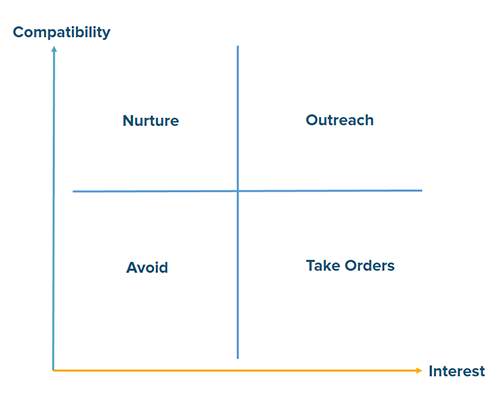 I've spoken to several business owners that have adopted inbound marketing recently and have heard some variation of the following statement: "I'm getting a lot of traffic to my website and I'm converting leads, but I'm not getting the sales that I need."
I've spoken to several business owners that have adopted inbound marketing recently and have heard some variation of the following statement: "I'm getting a lot of traffic to my website and I'm converting leads, but I'm not getting the sales that I need."
Let's face it, for 99.7% of us, selling is not easy. I've met several salespeople in my career who made it look like selling was easy for them. But when I took a closer look at what they were doing, I found that they made it look easy because they had a good sales process and followed it religiously.
With that said, I'm going to lay out the framework for a process to close inbound leads. You may need to modify it for your business, but if you follow the process, you should increase your closing ratio for your inbound leads.
Segment inbound marketing leads by compatibility and interest
The first step for your sales process is determining is determined by assessing how compatible your inbound leads are with your ideal customer profile and by the level of engagement they've had with your inbound marketing process. Let's take a look at those two variables.
Compatibility is determined by how well the lead fits with your ideal customer profile. An ideal customer profile is a set of criteria that describe the type of prospects that are most likely to become profitable customers for you. Some of the criteria by which you can identify your ideal customer profile include:
- job title/seniority level
- industry
- company size
- geographic location
- internal structure (example: companies that have 5 or more salespeople)
These are just a few examples of how you might define your ideal customer profile. Most companies have more than one ideal customer profile.
The level of engagement with your inbound marketing process can be measured using your inbound marketing analytics. Some of the criteria that you may use to measure interest include:
- number of pageviews on your website
- number of website visits
- email opens and clickthroughs
- which pages the lead views (e.g. - someone who views your pricing page could be a potential buyer)
- number of lead conversions (e.g. - if they've downloaded 5 of your eBooks, they are indicating interest.)
- social media shares/retweets of your content
How you proceed with each lead depends on their level of interest and compatibility with your ideal customer profile.
Measuring your leads' compatibility and interest
Inbound marketing software like HubSpot lets you measure compatibility and interest objectively using marketing analytics.
How to measure compatibility
In the inbound marketing environment, you can use forms on landing pages to gather your ideal customer profile criteria. For example, if certain industries are in your sweet spot, ask leads to choose their industy on your form. I recommend using drop-down lists to make it easy for your leads to complete the form. Pick the qualifying criteria most important to you and include questions to gather them on your forms. This is the first level of determing compatibility with your ideal customer profile. With inbound marketing software like HubSpot, you can use the workflows function to segment leads by compatibility.
The second level of of evaluating fit to your ideal customer profile would be to have the designated sales person research the lead on LinkedIn and other sources to evaluate the fit to your ideal customer profile. With the lead intelligence gathered, a sales person can adjust the compatibility rating as necessary.
How to measure your lead's level of interest
Measuring the lead's level of interest is done with lead scoring. A lead scoring system is done by assigning point values for actions a lead takes on your website or social media channels. Once a lead exceeds a designated point value that indicates interest, notifications are sent to the sales person for outreach. For example, if a lead downloads an eBook on your site, she gets 5 points. Once her total points exceeds your goal level of 50 points, the lead is defined as interested and passed to sales for outreach. HubSpot has an automated lead scoring factor that lets you assign point values to your leads based on their interaction with your marketing process.
Don't expect your lead scoring and evaluation to be perfect at first. Use analytics and feedback from sales to adjust the process as necessary. Use your marketing software or CRM to provide timely notifications to sales.
Using compatibility and interest to determine sales outreach
Here's a graphical depiction of how to interact with your leads based on their levels of compatibility and interest.

Here's are the 4 different sales approaches you will take based on the level of compatibility and interest. Regardless of the lead evaluation, I recommend making an initial soft outreach within 24 hours of a new lead converting. This will make sure that you don't miss out on leads that are actively moving towards a buying decision.
High compatibility, high interest. These leads are a sales person's dream. They fit your ideal customer profile and are highly engaged with your marketing process. The action here is obvious: pick up the phone and call these people ASAP!
High compatibility, low interest. These leads fit your ideal customer profile, but are likely either early in their buying process or not in it all. Don't scare them away with an aggressive sales approach at this point. Nurture them with email marketing and share interesting content with them. The objective here is to stay with them as they move through their buying process.
Low compatibility, high interest. These leads don't fit your ideal customer profile, but are highly engaged with your inbound marketing process. They aren't worth spending a lot of time on. The recommendation here is to not actively pursue these leads, but consider doing business with them if they come to you. Your objective here is to take orders from these leads, but to not spend a lot of time pursuing them.
Low compatibility, low interest. These leads don't fit your ideal customer profile and aren't engaged with your marketing process. An example would be a competitor or student. The approach here is simple: avoid them and don't waste your time.
Summary
Unless you're an e-commerce company, inbound marketing leads don't sell themselves. You will eventually need to transition your relationship from online one to a personal relationship with your sales person. The good news for salespeople is that your sales process will create opportunities to work with qualified leads. They close these leads by helping them solve problems, not by using manipulative sales techniques. Align this approach to your company's growth strategy and you will optimize your closing ratio.








